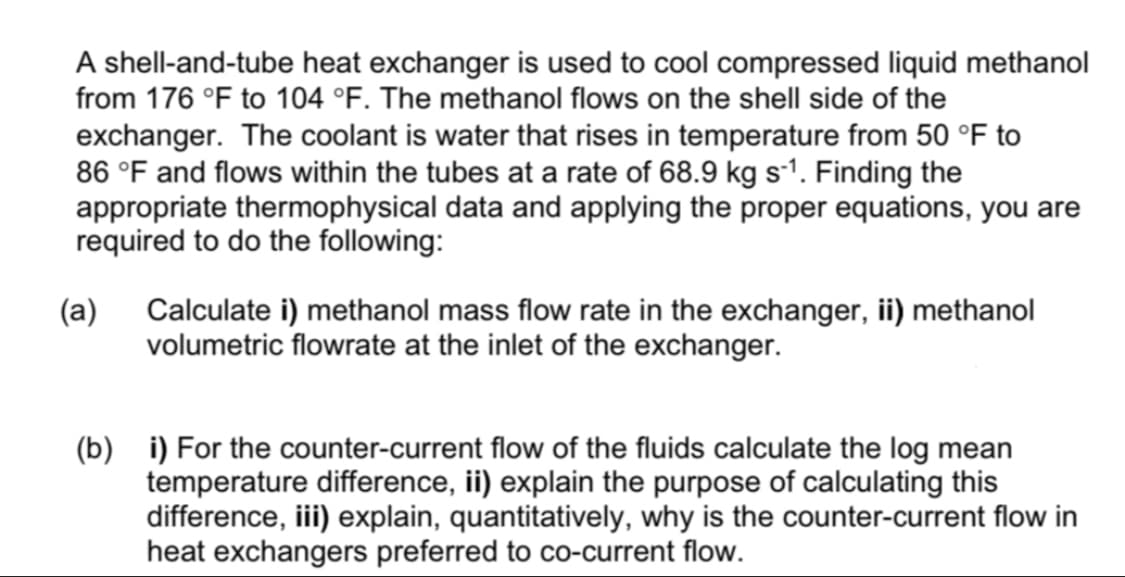A shell-and-tube heat exchanger is used to cool compressed liquid methanol from 176 °F to 104 °F. The methanol flows on the shell side of the exchanger. The coolant is water that rises in temperature from 50 °F to 86 °F and flows within the tubes at a rate of 68.9 kg s1. Finding the appropriate thermophysical data and applying the proper equations, you are required to do the following: (a) Calculate i) methanol mass flow rate in the exchanger, ii) methanol volumetric flowrate at the inlet of the exchanger. (b) i) For the counter-current flow of the fluids calculate the log mean temperature difference, ii) explain the purpose of calculating this difference iiil evplain quantitatively wby is the counter-current flow in
A shell-and-tube heat exchanger is used to cool compressed liquid methanol from 176 °F to 104 °F. The methanol flows on the shell side of the exchanger. The coolant is water that rises in temperature from 50 °F to 86 °F and flows within the tubes at a rate of 68.9 kg s1. Finding the appropriate thermophysical data and applying the proper equations, you are required to do the following: (a) Calculate i) methanol mass flow rate in the exchanger, ii) methanol volumetric flowrate at the inlet of the exchanger. (b) i) For the counter-current flow of the fluids calculate the log mean temperature difference, ii) explain the purpose of calculating this difference iiil evplain quantitatively wby is the counter-current flow in
Principles of Heat Transfer (Activate Learning with these NEW titles from Engineering!)
8th Edition
ISBN:9781305387102
Author:Kreith, Frank; Manglik, Raj M.
Publisher:Kreith, Frank; Manglik, Raj M.
Chapter6: Forced Convection Over Exterior Surfaces
Section: Chapter Questions
Problem 6.38P
Related questions
Concept explainers
Heat Exchangers
Heat exchangers are the types of equipment that are primarily employed to transfer the thermal energy from one fluid to another, provided that one of the fluids should be at a higher thermal energy content than the other fluid.
Heat Exchanger
The heat exchanger is a combination of two words ''Heat'' and ''Exchanger''. It is a mechanical device that is used to exchange heat energy between two fluids.
Question

Transcribed Image Text:A shell-and-tube heat exchanger is used to cool compressed liquid methanol
from 176 °F to 104 °F. The methanol flows on the shell side of the
exchanger. The coolant is water that rises in temperature from 50 °F to
86 °F and flows within the tubes at a rate of 68.9 kg s1. Finding the
appropriate thermophysical data and applying the proper equations, you are
required to do the following:
(a)
Calculate i) methanol mass flow rate in the exchanger, ii) methanol
volumetric flowrate at the inlet of the exchanger.
(b) i) For the counter-current flow of the fluids calculate the log
temperature difference, ii) explain the purpose of calculating this
difference, iii) explain, quantitatively, why is the counter-current flow in
heat exchangers preferred to co-current flow.
mean
Expert Solution
This question has been solved!
Explore an expertly crafted, step-by-step solution for a thorough understanding of key concepts.
Step by step
Solved in 2 steps with 1 images

Knowledge Booster
Learn more about
Need a deep-dive on the concept behind this application? Look no further. Learn more about this topic, mechanical-engineering and related others by exploring similar questions and additional content below.Recommended textbooks for you

Principles of Heat Transfer (Activate Learning wi…
Mechanical Engineering
ISBN:
9781305387102
Author:
Kreith, Frank; Manglik, Raj M.
Publisher:
Cengage Learning

Principles of Heat Transfer (Activate Learning wi…
Mechanical Engineering
ISBN:
9781305387102
Author:
Kreith, Frank; Manglik, Raj M.
Publisher:
Cengage Learning